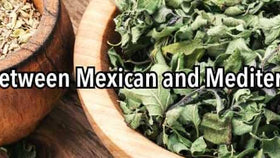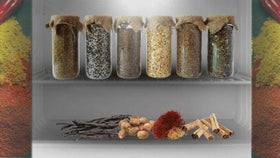What are The Best Vanilla Beans to Buy and Why?
A guide to buying vanilla beans online and selecting the right vanilla beans for you
Shopping online can be tough. Shopping for vanilla online can be even tougher so at Slofoodgroup, we have put together this guide to help you find, select and purchase the right vanilla bean or vanilla product for you. By understanding the basics you can buy vanilla with confidence knowing what to expect and how to choose the most suitable type and grade of vanilla beans based on your own specific needs.
What grade of vanilla beans are you looking for?
Did you know vanilla is graded into several different classifications based on the length of the vanilla pod, the moisture of the bean and other physical characteristics? Here we have outlined the most common classifications used in both the United States and Europe.
Grade A, also referred to as gourmet vanilla or black vanilla in Europe - this class of vanilla is average of 14 centimeters and above ( 5.512 inches for those that are not familiar with the metric sytem). Gourmet vanilla beans have little to no visible blemishes, spilts or breaks and have an average moisture content of 30-35 percent. The only vanilla bean in the world that has a higher humidity level than this is Tahitian vanilla from Tahiti, currently at 45-50 percent. The government of French Polynesia sets the moisture level for all vanilla from the islands of Tahiti. This is one of the signature characteristics of their vanilla beans and national identity giving the beans their subtle, floral and exotic aroma and flavor profile. It is the only bean that can be safely stored and stable such a high moisture level.
Grade A vanilla beans should be relatively plump, with an oily sheen and have a relatively soft and pliable outer pod that can be easily sliced open and scrapped to remove the vanilla seeds. This type of vanilla bean is favored by many users as the vanilla beans are both visually appealing and quite easy to work with. This grade of vanilla bean is perfect for baking application where using fresh vanilla beans is desired. Gourmet vanilla beans can also be used for making vanilla extract by simply increasing the amount of vanilla beans per cup by .10 percent.

Grade B, extract grade vanilla beans, referred to as red vanilla in Europe - this grade of vanilla is identified by being 14 centimeters and below. Grade B vanilla has visible blemishes and heavy red variegations running up and down the length of the pod. Red vanilla beans have an average moisture content of 23-27 percent and are specially dried for longer periods intended only for making vanilla extract. It is said, roughly 80 percent of the world supply of vanilla beans is used for making vanilla extract and vanilla paste. For vanilla beans to be considered grade b they do not need to meet all of these standards. The beans can be much longer than 14 cm and still be classified as grade b if their moisture content falls within the classification guidelines. The vanilla beans can also be shorter than 14 cm but have a slightly higher moisture content than 23-27 percent. This at times is referred to by some people as grade A/B but technically speaking, they are still extract grade vanilla beans. Grade b extract vanilla is most commonly used by home cooks and food manufacturers alike for making pure vanilla extract, vanilla flavor and vanilla bean powder.

The two most common types of commercially available vanilla beans, vanilla planifolia and vanilla tahitensis
Vanilla planifolia
Most famously of Madagascar. Common name for this type of vanilla bean is Bourbon vanilla grown in regions including Uganda, Papua New Guinea, Indonesia, Comoros, Madagascar, Mexico, Hawaii and even Florida. This type of vanilla is often rich in the familiar vanilla profile users expect due to its high levels of vanillin. Ironically enough vanillin is only one of the active chemical components that make up the full flavor profile of vanilla but it is highest in concentrations in the vanilla planifolia species of vanilla beans. Below we will touch on several different origins of this vanilla.
Ugandan Vanilla - a rich chocolate, fig, and even light raisin like notes shine through from the vanilla beans hailing from the pearl of Africa. These vanilla beans are a staff pick favorite for their distinctive flavor profile that will rival any origin in terms of quality producing vanilla planifolia.
Madagascar vanilla beans - Much like the Chicago bulls in the early 90's, vanilla from Madagascar has reigned king for so long that most people do not even think of any other vanilla bean when the term vanilla is used. Madagascar produces more vanilla than all countries combined and does so with such consistency and quality that they are always looked on as the gold standard. Vanilla beans from Madagascar are creamy, mellow, with notes of dried fruits and soft tobacco. This is most peoples favorite vanilla in either grade A or grade B and works great for hot or cold applications, making vanilla extract and more.
Papua New Guinea bourbon style vanilla - interestingly unique. Vanilla planifolia from PNG has a slightly smokey profile and is closer to dark chocolate than milk chocolate in profile. These vanilla beans, when you can find them, have been shown to have a higher vanillin content than other vanilla beans. Slofoodgroup is a leading supplier of vanilla beans from Papua New Guinea (both planifolia and tahitensis) world-wide. We have been supporting farms and villages in this region since 2014 and remain committed to showing the full potential of Papua New Guinea vanilla beans for the world to see.
Vanilla x Tahitensis
Less than one percent of vanilla world-wide is true Tahitian vanilla. Tahitian vanilla is a hybrid vanilla that was first found growing up trees in French Polynesia having escaped cultivation and occurring naturally in the wild. It is thought to be cross between several types of vanilla orchid species and reflects unique locational genetic factors that are still being researched to this day. This species of vanilla is found growing in French Polynesia, Papua New Guinea, Indonesia, and recently Ecuador and other parts of South America.
Vanille de Tahiti - the true designation of vanilla specifically from the islands of French Polynesia and Tahiti. If vanilla from Madagascar is the king of vanilla, vanilla from Tahiti is the queen; soft, yet powerful, sweet yet alluring. This exotic and rare vanilla bean is consistently the worlds most expensive vanilla. It compromises less than one percent of vanilla production and is only grown by a handful of skilled growers and prepares. The unique moisture content and methods of preparation are done in order to preserve its world wide recognition, identify and heritage distinguishing Vanille de Tahiti from all other Tahitian vanilla imposters.

Tahitian vanilla from Papua New Guinea - Tahitian vanilla in Papua New Guinea first began growing in several regions of this island chain commonly referred to as the last frontier in the 1960's. Known for being remote with highly inaccessible mountain regions PNG is now known for its' vanilla beans. Vanilla from PNG is cured similar to Madagascar bourbon vanilla beans. The green beans are first water killed, wrapped in blankets to sweat and then taken through a series of sunning, sweating, shade drying and inbox curing until the final product is ready for sale. Some areas do also adhere to the traditional practice of killing the vanilla beans in the sun but these vanilla beans are usually dried to moisture levels similar to their planifolia cousin rather than queen vanilla from Tahiti. These vanilla beans have a more subtle aroma that is floral, sweet and fragrant with notes of cherry, spices and hints of anise.
Tahitian vanilla from Ecuador - a relative new comer on the vanilla scene, Ecuador produces some highly quality vanilla beans that are extremely fragrant and concentrated. Notes of grape, balsamic, cherry reduction and medicinal are used to describe these vanilla beans from South America. Ecuador is known for quality agriculture like coffee, cocoa, bananas, and now vanilla.
Do not judge a book or in our case bean by its cover
Now you are armed with the basic fundamentals of vanilla beans, what you do with it is up to you. We hope this article provides our readers with insight and easy to follow guidance for buying the right vanilla beans for what ever your application maybe. Thanks for reading and as always, happy baking.







Slofoodgroup
Author